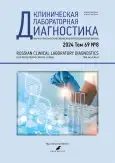Autoantibodies: selection of blood for individual compatibility
- Authors: Galygo N.V.1, Demkova O.V.1, Koryakina L.B.1, Misharina N.P.1
-
Affiliations:
- Irkutsk regional clinical hospital, winner of the “Mark of the Honor” award
- Issue: Vol 69, No 8 (2024)
- Pages: 162-170
- Section: Clinical Case Reports
- Published: 17.10.2024
- URL: https://kld-journal.fedlab.ru/0869-2084/article/view/633776
- DOI: https://doi.org/10.17816/cld633776
- ID: 633776
Cite item
Abstract
BACKGROUND: Screening and identification of antierythrocyte antibodies before transfusion of erythrocyte-containing components contributes to the most accurate selection of donor blood components compatible for the recipient, which reduces the risk of posttransfusion reactions and complications.
CLINICAL CASE DESCRIPTION: Female patient X., age 62, was admitted to the hematology department with a diagnosis of “Iron deficiency anemia, unspecified”. Autoantibodies and antierythrocytic antibodies of the Rhesus system were identified — anti-e antibodies. Conducting a test for individual compatibility of blood components is difficult: the incompatibility of blood components in an indirect antiglobulin test is due to the presence of autoantibodies.
CONCLUSION: An integral part of specialized medical care is blood transfusion, which is based on the immunohematological compatibility of the donor and recipient. At the same time, the safety of transfusion of donated blood and its components is the most important principle of providing transfusion care in medical organizations. Screening of antierythrocyte alloantibodies is a mandatory pretransfusion test. However, the antibody identification process is difficult in the presence of thermal autoimmune antibodies in the plasma under study. To confirm the presence of autoantibodies in the test sample, a direct antiglobulin test (DAGT) is necessary. The standard way to “get rid” of autoimmune antibodies is to use the absorption–elution method, however, the complexity of the technique limits its use in immunohematology laboratories in routine practice.
Full Text
About the authors
Nadezhda V. Galygo
Irkutsk regional clinical hospital, winner of the “Mark of the Honor” award
Email: nadezhda.galygo@mail.ru
ORCID iD: 0009-0007-9481-6340
SPIN-code: 7205-4580
Russian Federation, 100 Yubileiny microdistrict, 664059 Irkutsk
Olga V. Demkova
Irkutsk regional clinical hospital, winner of the “Mark of the Honor” award
Author for correspondence.
Email: demkova-olga@mail.ru
ORCID iD: 0009-0002-4688-3673
SPIN-code: 2272-4181
Russian Federation, 100 Yubileiny microdistrict, 664059 Irkutsk
Larisa B. Koryakina
Irkutsk regional clinical hospital, winner of the “Mark of the Honor” award
Email: koryakina-asld@rambler.ru
ORCID iD: 0000-0003-1999-8272
SPIN-code: 9238-2032
MD, Cand. Sci. (Medicine)
Russian Federation, 100 Yubileiny microdistrict, 664059 IrkutskNatalya P. Misharina
Irkutsk regional clinical hospital, winner of the “Mark of the Honor” award
Email: misharina_np@mail.ru
Russian Federation, 100 Yubileiny microdistrict, 664059 Irkutsk
References
- Krobinets II, Mineeva NV, Bodrova NN, et al. Features of the anti-erythrocyte antibodies screening results interpretation in patients with hematological diseases. Kazan medical journal. 2022;103(1):14–22. EDN: WOVVZH doi: 10.17816/KMJ2022-14
- Pokhabov DS, Fomina AYu, Shestakov EA, Zhiburt EB. KEL1 erythrocyte antigen in a new form of medical history. Astrakhan Medical Journal. 2023;18(4):6–10. EDN: BBYPQJ doi: 10.17021/1992-6499-2023-4-6-10
- Efremova VV, Aprosimov LA, Davydova LE, et al. Hemotransfusion complications in medical organizations of the Republic of Sakha (Yakutia). Vestnik of North-Eastern Federal University. Medical Sciences. 2024;(2):45–52. EDN: TKHFBX doi: 10.25587/2587-5590-2024-2-45-52
- Mineeva NV, Krobinets II, Bodrova NN, Bogdanova IO. The use of direct antiglobulin test for the detection of autoantibodies in anemia of various genesis. Oncohematology. 2017;12(3):57–62. EDN: ZNEFBB doi: 10.17650/1818-8346-2017-12-3-57-62
- Zhiburt EB, Kuznecov SI. Pacientu nevozmozhno podobrat’ eritrocity dlya transfuzii. Shest’ situacij, kogda perelivanie nesovmestimoj krovi dopustimo. Spravočnik zaveduûŝego KDL. 2019;(11):22–27. (In Russ.). EDN: NDDBJD
- Butina EV, Mineeva NV, Zaitseva GA, et al. Red blood cell alloimmunization in patients with hematology/oncology disorders. Transfusiology. 2019;20(2):27–34. EDN: PHZHOE
- Yovdiy AV, Butina EV, Poponina EA, et al. Interpretation of the results of immunohematological studies in patients of the hematology clinic. Russian Clinical Laboratory Diagnostics. 2019;64(4):221–224. doi: 10.18821/0869-2084-2019-64-4-221-224
- Zhiburt EB, Shestakov EA, Kuznetsov SI. Hemolytic transfusion reactions. Bulletin of Pirogov National Medical & Surgical Center. 2019;14(4):105–111. EDN: FYAYWE doi: 10.25881/BPNMSC.2020.17.22.020
Supplementary files















